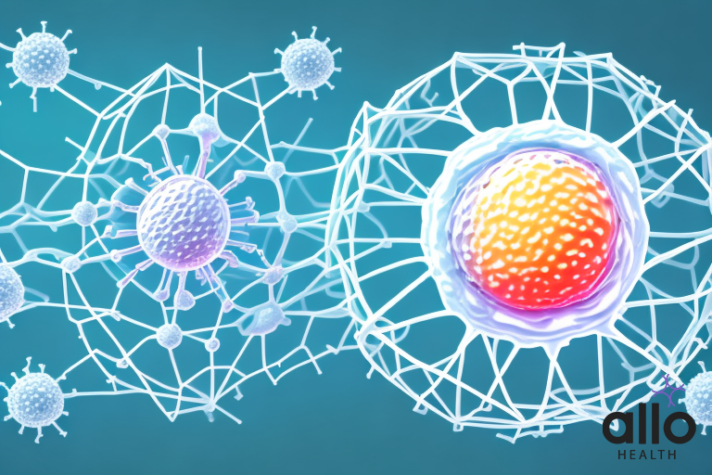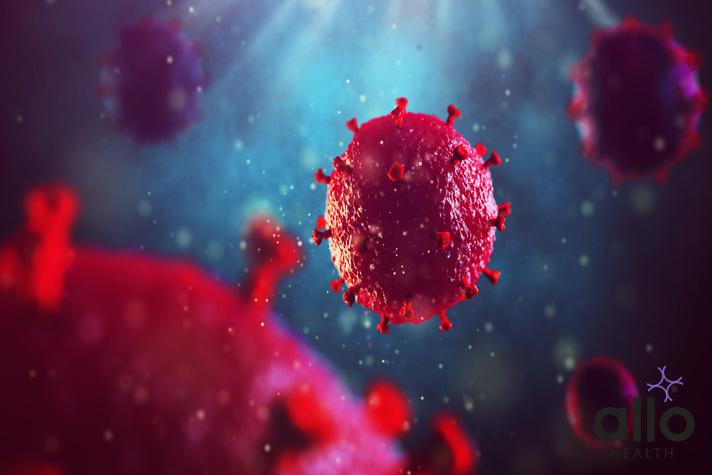Is Balanitis a Symptom of HIV?

Allo Health is dedicated to personalized well-being, offering support and trusted information tailored to individual health goals. The platform emphasizes human-generated content, led by a distinguished medical team of experts, including physicians and sexual health specialists. Their commitment to credibility involves rigorous fact-checking, authoritative research, and continuous updates to ensure accurate, up-to-date information. Allo Health's unique approach goes beyond conventional platforms, providing expert-led insights and a continuous commitment to excellence, with user feedback playing a crucial role in shaping the platform's authoritative voice.

Dr. Raj. R holds an undergraduate medical degree from the Philippines, and has a bachelors background in Psychology. His experience working in the field of urology further brought his interest forward in working towards his passion of understanding the science of attraction, intimacy, sex and relationships. A key motto he practices by remains unprejudiced and non-judgemental care.
Why This Was Upated?
Our experts continually monitor the health and wellness space, and we update our articles when new information became available.
Updated on 09 February, 2024
- Article was updated as part of our commitment to diversity, equity, and inclusion.

"The following blog article provides general information and insights on various topics. However, it is important to note that the information presented is not intended as professional advice in any specific field or area. The content of this blog is for general educational and informational purposes only.
Book consultation
The content should not be interpreted as endorsement, recommendation, or guarantee of any product, service, or information mentioned. Readers are solely responsible for the decisions and actions they take based on the information provided in this blog. It is essential to exercise individual judgment, critical thinking, and personal responsibility when applying or implementing any information or suggestions discussed in the blog."
Balanitis, an inflammation of the head of the penis, is a common condition that affects men of all ages. It can occur due to a range of causes, including poor hygiene, fungal infections, and bacterial infections. However, there is a lot of confusion and misinformation surrounding the connection between balanitis and HIV. Some people believe that balanitis is a symptom of HIV, while others claim that it is not related to the virus at all. In this article, we will discuss the causes, symptoms, and treatment options for balanitis in people with HIV, as well as the potential link between the two conditions.
Balanitis Overview
Balanitis is a medical condition characterized by the inflammation of the glans penis, which is the rounded tip of the penis. It can affect males of any age, from infants to elderly individuals. Balanitis can be caused by various factors, including infections, irritants, or underlying medical conditions. Here’s an overview of balanitis in detail:
Causes:
- Infections:
- Bacterial Infections: Common bacteria like Streptococcus or Staphylococcus can cause balanitis.
- Fungal Infections: Candida (yeast) is a common cause, especially in individuals with diabetes or those taking antibiotics.
- Sexually Transmitted Infections (STIs): Infections such as gonorrhea or chlamydia can lead to balanitis.
- Poor Hygiene: Inadequate cleaning of the genital area may lead to the accumulation of smegma, a substance that can contribute to irritation and inflammation.
- Irritants: Harsh soaps, detergents, or chemical substances can irritate the delicate skin of the glans and lead to inflammation.
- Allergic Reactions: Some individuals may be allergic to certain materials present in condoms, lubricants, or personal care products.
- Diabetes: Men with diabetes are at an increased risk of developing balanitis, possibly due to higher glucose levels promoting yeast growth.
- Phimosis: A condition where the foreskin is too tight, preventing proper cleaning and leading to an increased risk of infection.
- Autoimmune Disorders: Conditions like lichen planus or psoriasis can affect the skin, including the genital area.
Symptoms:
- Redness and Swelling: Inflammation of the glans penis, often accompanied by redness and swelling.
- Itching or Irritation: Persistent itching or irritation in the affected area.
- Pain or Discomfort: Pain or discomfort, especially during urination.
- Discharge: White or yellow discharge from the penis.
- Foul Odor: Unpleasant odor, particularly if caused by infection.
- Difficulty Retracting the Foreskin: In cases of phimosis, difficulty retracting the foreskin.
Diagnosis:
- Medical History and Physical Examination: A healthcare provider will inquire about symptoms and perform a physical examination.
- Cultures and Tests: Lab tests, including cultures, may be conducted to identify the specific cause of infection.
- Blood Sugar Tests: Individuals with suspected diabetes may undergo blood sugar tests.
- Biopsy (in severe cases): In certain situations, a biopsy may be performed to analyze the tissue.
Treatment:
- Hygiene: Improved genital hygiene is crucial. Cleaning the area regularly can help prevent and alleviate symptoms.
- Topical Medications: Antifungal or antibacterial creams or ointments may be prescribed based on the cause.
- Oral Medications: In cases of severe infection, oral antibiotics or antifungal medications may be recommended.
- Corticosteroids: Topical corticosteroids can be prescribed to reduce inflammation.
- Avoiding Irritants: Identifying and avoiding potential irritants, such as harsh soaps or allergenic substances.
- Treatment of Underlying Conditions: Management of underlying conditions like diabetes.
Prevention:
- Good Hygiene Practices: Regular cleaning of the genital area.
- Avoiding Irritants: Using mild soaps and avoiding harsh chemicals.
- Safe Sex Practices: Using condoms and practicing safe sex to prevent STIs.
- Managing Underlying Conditions: Proper management of conditions like diabetes.
It’s important for individuals experiencing symptoms of balanitis to seek medical attention for an accurate diagnosis and appropriate treatment. Early intervention can prevent complications and promote faster recovery.

HIV Overview
Human Immunodeficiency Virus (HIV) is a virus that attacks the immune system, specifically the CD4 cells (T cells), which help the immune system fight off infections. If left untreated, HIV can lead to the disease Acquired Immunodeficiency Syndrome (AIDS), a condition where the immune system is severely damaged and the individual becomes susceptible to opportunistic infections and certain cancers. Here is a detailed overview of HIV:
Causes and Transmission:
- Virus Type: HIV is a retrovirus that comes in two main types: HIV-1 and HIV-2. HIV-1 is the most common and globally prevalent.
- Transmission:
- Sexual Contact: Unprotected sexual intercourse with an infected person is a common mode of transmission.
- Blood-to-Blood Contact: Sharing needles or syringes, or receiving contaminated blood or blood products can transmit HIV.
- Mother-to-Child Transmission: HIV can be transmitted from an infected mother to her child during childbirth or breastfeeding.
Stages of HIV Infection:
- Acute HIV Infection: The initial stage after infection, often accompanied by flu-like symptoms. This phase can last a few weeks.
- Clinical Latency (Chronic HIV Infection): Asymptomatic or mild symptoms persist for several years. The virus is actively replicating, but the immune system is still functioning to some extent.
- AIDS (Acquired Immunodeficiency Syndrome): The final stage of HIV infection. CD4 cell count drops significantly, and the individual becomes vulnerable to opportunistic infections and certain cancers.
Symptoms:
- Early Symptoms: Fever, fatigue, swollen lymph nodes, sore throat, rash, muscle and joint aches.
- Chronic Symptoms: Persistent, unexplained fatigue, weight loss, recurrent fever, and night sweats.
- Advanced HIV (AIDS): Opportunistic infections (e.g., tuberculosis, pneumonia), severe weight loss, neurological complications, and certain cancers.
Diagnosis:
- HIV Antibody Test: Blood tests detect antibodies produced by the immune system in response to HIV infection.
- Nucleic Acid Test (NAT): Detects the genetic material of the virus and is often used in early detection.
Treatment:
- Antiretroviral Therapy (ART): A combination of medications that suppress the replication of the virus, slowing down the progression of HIV and preventing AIDS-related complications.
- Pre-Exposure Prophylaxis (PrEP): Medication taken by individuals at high risk of HIV to prevent infection.
Prevention:
- Safe Sex Practices: Using condoms consistently and correctly during sexual intercourse.
- Needle Exchange Programs: Providing clean needles and syringes to reduce the risk of HIV transmission among injection drug users.
- Testing and Awareness: Regular HIV testing, especially for individuals with high-risk behaviors, and increasing awareness about the virus.
- Treatment as Prevention: Early initiation of ART can reduce the risk of transmission to uninfected partners.

Challenges:
- Stigma and Discrimination: HIV/AIDS is often associated with stigma and discrimination, affecting individuals’ willingness to get tested and seek treatment.
- Access to Treatment: In some regions, access to antiretroviral therapy may be limited, impacting the ability to manage and control the spread of HIV.
- Global Impact: HIV/AIDS has a significant impact on public health, especially in sub-Saharan Africa, where prevalence rates are higher.
Research and Developments:
- Vaccine Research: Ongoing efforts to develop a preventive HIV vaccine.
- Cure Research: Investigations into finding a cure for HIV, aiming to eliminate the virus from the body.
HIV is a complex virus that requires a multifaceted approach for prevention, diagnosis, and treatment. Advances in research, education, and access to healthcare have improved outcomes for individuals living with HIV, but continued efforts are needed to combat the global impact of the epidemic. Early detection, prompt treatment, and public awareness are essential components of HIV prevention and management.
Is Balanitis a Symptom of HIV?
Balanitis itself is not a direct symptom of HIV, but there can be an indirect connection. Balanitis is the inflammation of the glans penis, and it can be caused by various factors such as infections, irritants, or underlying medical conditions. While HIV does not directly cause balanitis, the weakened immune system associated with advanced HIV or AIDS can make individuals more susceptible to infections, including those that might contribute to balanitis.
Here’s a more detailed explanation:
- HIV and Immune System: HIV primarily targets and weakens the immune system, specifically the CD4 cells (T cells), which play a crucial role in the body’s defense against infections. As HIV progresses, the immune system becomes compromised, and the body becomes more susceptible to various infections and illnesses.
- Increased Vulnerability to Infections: Individuals with advanced HIV or AIDS may experience a weakened ability to fight off infections. This weakened immune response can make them more prone to various opportunistic infections, including fungal or bacterial infections that could contribute to balanitis.
- Opportunistic Infections and Balanitis: Opportunistic infections are infections that take advantage of a weakened immune system. While balanitis itself is not a specific opportunistic infection associated with HIV, the conditions that lead to balanitis (such as fungal or bacterial infections) may be more likely to occur in individuals with compromised immune systems.
- Other Factors: It’s important to note that balanitis can occur in individuals who do not have HIV as well. Common causes include poor hygiene, irritants, diabetes, certain medications, or sexually transmitted infections. The presence of balanitis alone does not necessarily indicate HIV.
- Routine Testing: If someone is experiencing symptoms of balanitis or any other health concerns and is concerned about HIV, it is advisable for them to undergo routine HIV testing. HIV testing is important for early detection and timely initiation of treatment.
- Prevention and Management: Practicing safe sex, maintaining good hygiene, and managing underlying health conditions are important for preventing balanitis. For individuals with HIV, adherence to antiretroviral therapy (ART) is crucial for maintaining a healthier immune system and preventing complications.
While balanitis itself is not a symptom of HIV, the weakened immune system associated with advanced HIV or AIDS can make individuals more susceptible to infections that may contribute to balanitis. If someone is concerned about HIV or experiencing symptoms, it is advisable to consult with a healthcare professional for appropriate testing and guidance.
Most Asked Questions
-
What is the advocated amoxicillin 500mg dosage for syphilis remedy?
The recommended dosage of amoxicillin for syphilis is generally 500 mg, taken three times an afternoon for a period decided by using your healthcare provider. It is important to follow the prescribed regimen to make sure effective remedy and save you the development of antibiotic resistance.
-
How does amoxicillin work in treating syphilis?
Amoxicillin is an antibiotic that belongs to the penicillin class. It works via inhibiting the increase of the bacteria responsible for syphilis, Treponema pallidum. By interfering with the micro organism's ability to shape cell partitions, amoxicillin efficiently removes the infection from the body.
-
Can I self-prescribe amoxicillin for syphilis with out consulting a healthcare expert?
No, it isn't always beneficial to self-prescribe amoxicillin or some other antibiotic for syphilis with out consulting a healthcare professional. Proper analysis and remedy making plans are essential to ensure the precise antibiotic, dosage, and period are prescribed, taking into consideration man or woman health factors and the level of the infection.
-
Are there potential facet effects related to amoxicillin 500mg for syphilis?
Common side results of amoxicillin might also include nausea, diarrhea, and hypersensitive reactions. It is essential to tell your healthcare issuer of any hypersensitive reactions or detrimental reactions to antibiotics. If you enjoy excessive side effects, touch your healthcare company directly.
-
What precautions must I take while the usage of amoxicillin for syphilis?
Inform your healthcare issuer approximately any existing scientific situations, allergic reactions, or medicines you are taking. Take the total direction of amoxicillin as prescribed, even supposing signs and symptoms improve earlier than final touch. Avoid alcohol all through treatment. Regular observe-americawith your healthcare provider are important to monitor progress and address any worries.






































